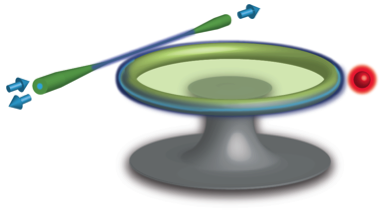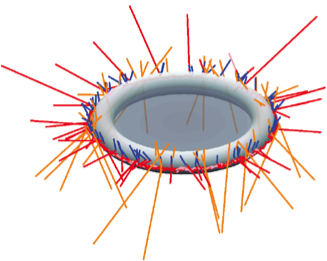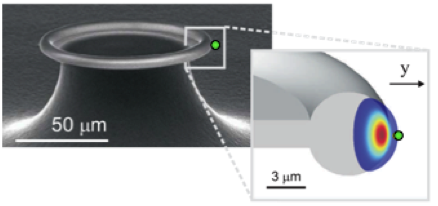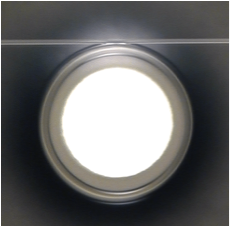Quantum Optics – Lab 1 – Website (Oct-09-2011)
Quantum
control of strong interactions between a single atom and one
photon has been achieved within the setting of cavity quantum
electrodynamics (cQED)
[1]. To move beyond proof-of-principle
experiments involving one or two conventional optical cavities to
more complex scalable systems that employ N >> 1 microscopic
resonators requires localization of atoms on distance scales ~100
nm from a resonator’s surface where an atom can be strongly
coupled to a single intracavity photon.
 |
 |
|
| Fig. 1: Evanescent field of circulating microtoroid mode allows optical input/output coupling to a tapered fiber and coupling to single atoms. | Fig. 2: Monte-Carlo simulation of atomic trajectories showing the dynamics of falling Cesium atoms as they transit in close proximity to a silica toroid. |
A promising
candidate for the realization of such systems is a system of
microtoroidal resonators that are optically coupled via tapered
nanofibers
[2]. Cavity QED interactions between falling single
atoms and single intracavity photons in such a system has been
achieved in the strong coupling regime [3], followed by
demonstrations of dynamic regulation of photon transport [4,5].
Recent study allows observations of perturbative surface effects mediated by atom’s radiative interactions, due to its proximity to the dielectric boundary of the resonator, and cQED dynamics in the strong coupling regime [6,7]. In this initial step into a new regime of cQED, we use real-time detection and high-bandwidth feedback to select and monitor the motion of a single Cesium atom through the evanescent field of a microtoroid. Direct temporal and spectral measurements along with simulations reveal the manifestly quantum nature of strongly coupled atom-cavity dynamics, and the significant role the Casimir effect and light forces play in the atom dynamics. This interplay is significant and important in determining the dynamics of cQED systems involving strongly interacting single atoms in close proximity to resonator boundaries, setting the stage for trapping strongly interacting atoms near micro- and nano-scopic optical resonators. Our research currently focuses on the realization of single atom trapping in this new regime of cavity QED.
Recent study allows observations of perturbative surface effects mediated by atom’s radiative interactions, due to its proximity to the dielectric boundary of the resonator, and cQED dynamics in the strong coupling regime [6,7]. In this initial step into a new regime of cQED, we use real-time detection and high-bandwidth feedback to select and monitor the motion of a single Cesium atom through the evanescent field of a microtoroid. Direct temporal and spectral measurements along with simulations reveal the manifestly quantum nature of strongly coupled atom-cavity dynamics, and the significant role the Casimir effect and light forces play in the atom dynamics. This interplay is significant and important in determining the dynamics of cQED systems involving strongly interacting single atoms in close proximity to resonator boundaries, setting the stage for trapping strongly interacting atoms near micro- and nano-scopic optical resonators. Our research currently focuses on the realization of single atom trapping in this new regime of cavity QED.
 |
 |
|
| Fig. 3: A Scanning-Electron-Microscope (SEM) image of a toroid with an illustrative atom and whispering-gallery-mode profile shown in the inset. | Fig. 4: Light coupled in and out of an ultra-high-Q microtoroidal whispering-gallery-mode resonator via a tapered optical fiber. |
Team members:
Jeff Kimble Group
Current team:
Daniel J. Alton, Pol Forn-Diaz, Andrew McClung, Martin Pototschnig
(Alumni: Clement Lacroute, Nathaniel P. Stern, Takao Aoki, Cindy A. Regal, Barak Dayan, Elizabeth Wilcut-Connolly, A. Scott Parkins)
Collaborators on fiber trap project:
Akihisa Goban, Ding Ding, Juan Muniz, Jae Hoon Lee
(Alumni: Kyung S. Choi, Darrick Chang, Tobias Thiele)
Kerry Vahala Group
Hansuek Lee
(Alumni: Eric Ostby, Sean Spillane, Tobias Kippenberg)
References:
[1] H. J. Kimble, Nature 453, 1023-1030 (2008).
[2] S. M. Spillane, T. J. Kippenberg, and K. J. Vahala; K. W. Goh, E. Wilcut, and H. J. Kimble, Phys. Rev. A 71, 013817 (2005).
[3] T. Aoki, B. Dayan, E. Wilcut, W. P. Bowen, A. S. Parkins, T. J. Kippenberg, K. J. Vahala, and H. J. Kimble, Nature 442, 671-674 (2006).
[4] B. Dayan, A. S. Parkins, T. Aoki, E. P. Ostby, K. J. Vahala, and H. J. Kimble, Science 319, 1062 (2008).
[5] T. Aoki, A. S. Parkins, D. J. Alton, C. A. Regal, B. Dayan, E. Ostby, K. J. Vahala, and H. J. Kimble, Phys. Rev. Lett. 102, 083601 (2009).
[6] D. J. Alton, N. P. Stern, Takao Aoki, H. Lee, E. Ostby, K. J. Vahala, and H. J. Kimble, Nature Phys. 7, 159 (2011).
[7] N. P. Stern, D. J. Alton, H. J. Kimble, New J. Phys. 13, 085004 (2011).
* In collaboration with Vahala Group led by Prof. Kerry Vahala at Caltech
* Member of IQIM – Caltech Institute for Quantum Information and Matter
* Supported by NSF, DoD NSSEFF program, AFOSR MURI for Quantum Memories, Gordon and Betty Moore foundation, Northrop Grumman Corporation, ARO, and DARPA